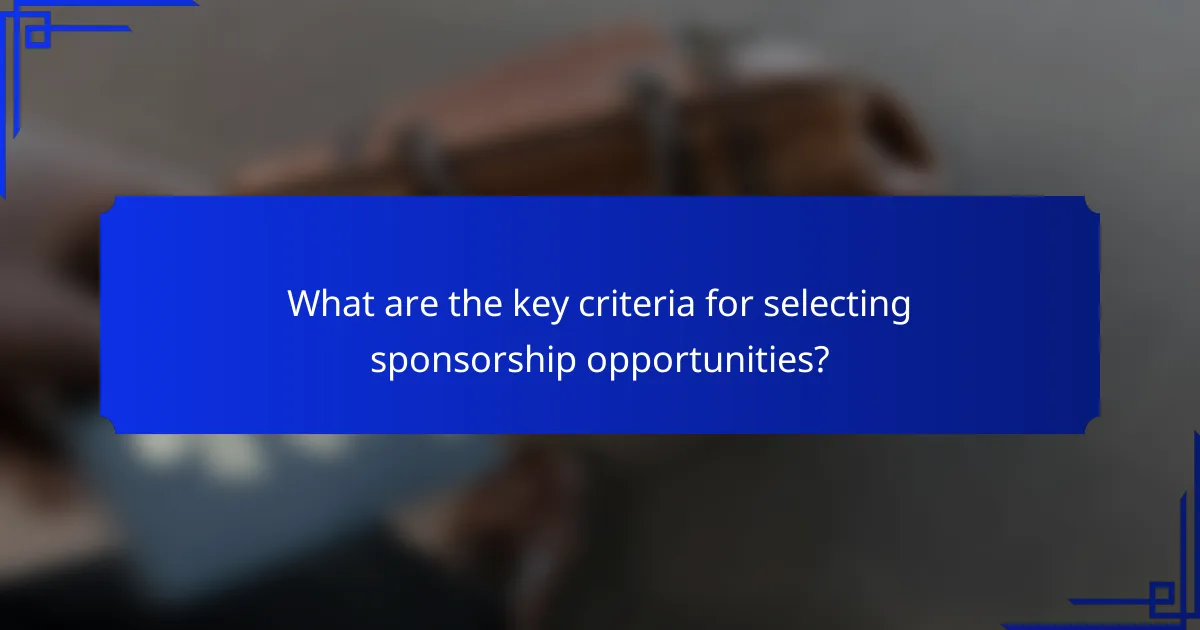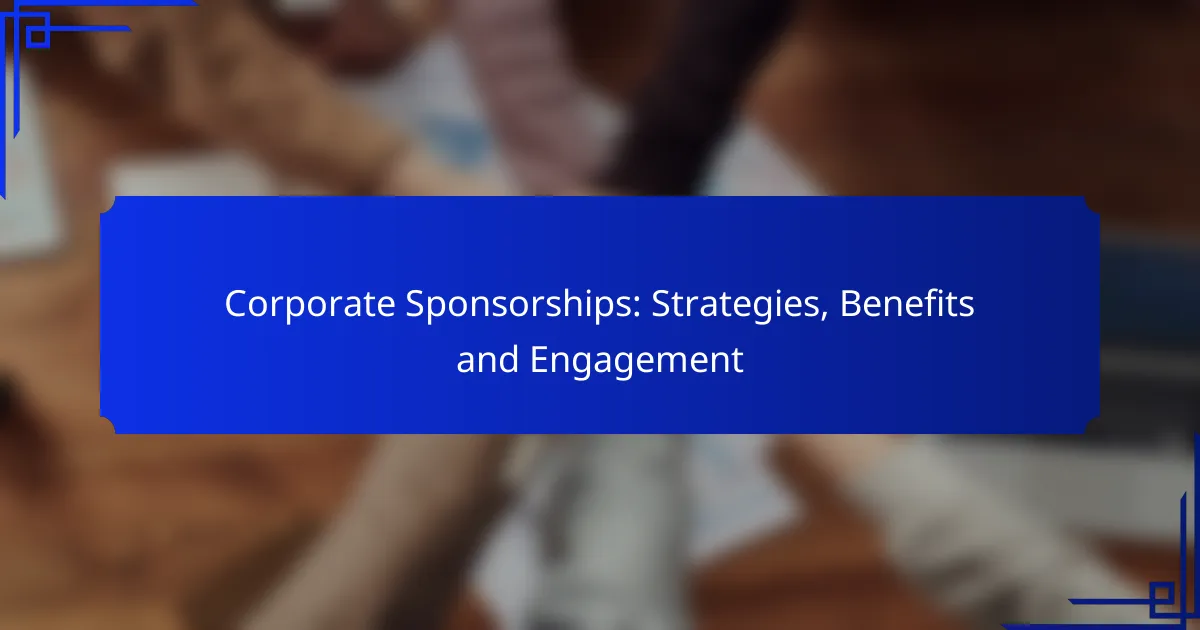Corporate sponsorships represent a strategic opportunity for brands to align their objectives with the interests of target audiences and communities. By effectively leveraging these partnerships, companies can enhance visibility, improve reputation, and engage with new demographics, ultimately strengthening their market position. Measuring the success of these initiatives through various metrics allows organizations to assess their impact and refine future sponsorship strategies.

What are effective corporate sponsorship strategies?
Effective corporate sponsorship strategies focus on aligning brand objectives with the interests of target audiences and communities. By leveraging these strategies, companies can enhance their visibility, foster engagement, and build lasting partnerships.
Targeted audience alignment
Targeted audience alignment involves identifying and connecting with specific demographics that resonate with the brand’s values. Companies should conduct market research to understand the interests and preferences of their potential sponsors’ audiences.
For example, a sports brand might sponsor youth athletic programs to reach active families, while a tech company could support educational initiatives in schools to engage students and educators. This alignment ensures that sponsorship efforts are relevant and impactful.
Brand visibility enhancement
Enhancing brand visibility through sponsorships means strategically placing logos and messaging in high-traffic areas where target audiences are present. This can include event signage, promotional materials, and digital platforms.
Utilizing social media to amplify sponsorship announcements can also significantly increase reach. Brands should consider partnerships that offer multimedia exposure, such as live-streamed events or interactive experiences, to maximize visibility.
Community engagement initiatives
Community engagement initiatives focus on building relationships with local populations through sponsorships that support community needs. This can involve sponsoring local events, charities, or programs that address social issues relevant to the community.
For instance, a company might sponsor a local food bank or environmental clean-up efforts, demonstrating a commitment to social responsibility. Engaging with the community fosters goodwill and can enhance brand loyalty among local consumers.
Collaborative marketing campaigns
Collaborative marketing campaigns involve working with sponsors to create joint promotional efforts that benefit both parties. These campaigns can leverage shared resources and audiences, resulting in greater impact than individual efforts.
For example, a beverage company and a music festival could collaborate on a campaign that includes co-branded merchandise and social media promotions. This synergy can lead to increased sales and brand recognition for both entities.
Long-term partnership development
Long-term partnership development focuses on nurturing ongoing relationships with sponsors rather than one-off engagements. This approach allows for deeper collaboration and more significant impact over time.
Companies should aim to establish clear communication and shared goals with their sponsors. Regular check-ins and evaluations can help ensure that both parties are benefiting from the partnership, leading to sustained success and potential future collaborations.

What are the benefits of corporate sponsorships?
Corporate sponsorships offer numerous advantages, including increased visibility for brands, improved reputation, and opportunities to engage with new audiences. These benefits can significantly enhance a company’s market position and foster valuable relationships.
Increased brand awareness
Corporate sponsorships can dramatically boost brand awareness by associating a company with popular events, organizations, or causes. This visibility can lead to heightened recognition among target audiences, especially when sponsorships are aligned with the brand’s values.
For example, sponsoring a major sporting event can expose a brand to thousands of attendees and millions of viewers, creating lasting impressions. Companies should consider the reach and demographics of the event to maximize their impact.
Enhanced corporate reputation
Engaging in corporate sponsorships can enhance a company’s reputation by demonstrating commitment to community and social responsibility. When businesses support charitable causes or local initiatives, they can cultivate goodwill among consumers and stakeholders.
Brands that are seen as socially responsible often enjoy increased loyalty and trust. It’s essential to choose sponsorships that align with the company’s mission and values to ensure authenticity in messaging.
Access to new customer segments
Corporate sponsorships can provide access to new customer segments that may not have been previously reached. By aligning with events or organizations that attract different demographics, companies can expand their market presence.
For instance, a tech company sponsoring a music festival may attract younger audiences who are interested in both technology and music. Understanding the target audience of the sponsorship is crucial for effective engagement and conversion.
Networking opportunities
Sponsoring events creates valuable networking opportunities for companies, allowing them to connect with potential clients, partners, and industry leaders. These interactions can lead to collaborations, partnerships, and new business ventures.
Attending sponsored events provides a platform for face-to-face engagement, which can strengthen relationships and facilitate discussions that may not occur in traditional business settings. Companies should actively participate in networking activities during these events to maximize their benefits.

How to measure the success of corporate sponsorships?
Measuring the success of corporate sponsorships involves evaluating various metrics that reflect financial returns, brand perception, and audience engagement. By analyzing these dimensions, organizations can determine the effectiveness of their sponsorship investments and make informed decisions for future initiatives.
Return on investment analysis
Return on investment (ROI) analysis quantifies the financial benefits derived from a sponsorship relative to its costs. To calculate ROI, compare the revenue generated from the sponsorship to the total expenses incurred, including activation costs and fees. A positive ROI indicates a successful sponsorship, while a negative ROI suggests a need for reassessment.
Consider using a simple formula: ROI = (Net Profit / Total Investment) x 100. For example, if a sponsorship costs $50,000 and generates $70,000 in revenue, the ROI would be 40%. Aim for an ROI that meets or exceeds industry benchmarks, typically ranging from 20% to 30% for effective sponsorships.
Brand perception surveys
Brand perception surveys assess how the target audience views a brand before and after a sponsorship. These surveys can include questions about brand awareness, favorability, and purchase intent. Conducting surveys at multiple points—prior to the sponsorship, during, and after—provides valuable insights into shifts in consumer attitudes.
Utilize a mix of qualitative and quantitative questions to gather comprehensive data. For instance, a Likert scale can measure agreement with statements about the brand, while open-ended questions can capture specific feedback. Analyzing this data helps identify the sponsorship’s impact on brand equity and informs future marketing strategies.
Engagement metrics tracking
Engagement metrics tracking involves monitoring audience interactions with the brand during the sponsorship. Key metrics include social media engagement, website traffic, and event attendance. Tools like Google Analytics and social media insights can provide real-time data on how audiences are responding to sponsorship-related content.
Set clear engagement goals prior to the sponsorship, such as increasing social media followers by a certain percentage or driving a specific number of website visits. Regularly review these metrics to assess performance and make adjustments as needed. Engaging with the audience through follow-up campaigns can further enhance the effectiveness of the sponsorship.

What are the key criteria for selecting sponsorship opportunities?
When selecting sponsorship opportunities, it’s essential to evaluate criteria that ensure alignment with your brand’s goals and target audience. Key factors include brand alignment, audience demographics, and the event’s overall reach and visibility.
Alignment with brand values
Choosing sponsorships that align with your brand values is crucial for authenticity and credibility. A partnership with an event or organization that shares similar principles can enhance your brand’s image and resonate with your audience.
For example, a company focused on sustainability should consider sponsoring eco-friendly events or initiatives. This alignment not only strengthens brand identity but also fosters trust among consumers who value those principles.
Target audience demographics
Understanding the demographics of the target audience is vital when selecting sponsorship opportunities. Ensure that the event attracts a demographic that matches your customer profile, including age, gender, income level, and interests.
For instance, if your product is aimed at young professionals, sponsoring events that cater to this group, such as networking events or industry conferences, can yield better engagement and return on investment.
Event reach and visibility
The reach and visibility of an event significantly impact the effectiveness of a sponsorship. Assess the expected attendance, media coverage, and promotional efforts associated with the event to gauge potential exposure for your brand.
Consider events with a strong online presence or those that are widely covered by local media, as these can amplify your brand’s visibility. Sponsoring large-scale events, like music festivals or major sporting events, often provides extensive exposure, but may require a larger budget.

How can companies engage with their sponsors effectively?
Companies can engage with their sponsors effectively by establishing clear communication channels, creating co-branded content, and implementing feedback mechanisms. These strategies foster a collaborative environment that enhances the partnership and maximizes mutual benefits.
Regular communication updates
Regular communication updates are essential for maintaining a strong relationship with sponsors. Companies should schedule consistent check-ins, whether through emails, calls, or meetings, to share progress, insights, and any changes in strategy.
Consider setting a monthly or quarterly update schedule to keep sponsors informed about campaign performance and upcoming initiatives. This transparency builds trust and allows for timely adjustments to strategies if needed.
Co-branded content creation
Co-branded content creation involves collaborating with sponsors to produce marketing materials that reflect both brands. This can include joint social media campaigns, blog posts, videos, or events that highlight the partnership.
When creating co-branded content, ensure that both parties’ values and messages align. This not only enhances brand visibility but also engages audiences by showcasing the partnership in a meaningful way.
Feedback and improvement loops
Implementing feedback and improvement loops is crucial for refining the partnership with sponsors. Regularly solicit feedback from sponsors regarding the effectiveness of campaigns and communication strategies.
Use surveys or informal discussions to gather insights and identify areas for improvement. This proactive approach demonstrates commitment to the partnership and can lead to more successful collaborations in the future.
